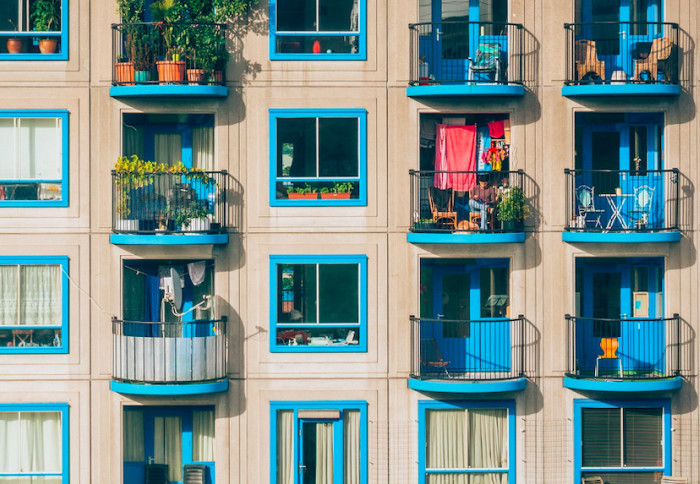Retrofit our homes to tackle multiple crises

Apartment block
Retrofitting our homes is one of the best ways to lower our energy costs, tackle climate change, and keep everyone healthy, says Dr Kate Simpson.
The UK is facing multiple crises – energy, cost of living, poverty, climate, and health. While it can’t solve everything, making our homes more energy efficient would go some way to helping these.
This would reduce energy needs, lower household bills, keep people warm, and cut UK emissions – one third of which come from energy use in the home.
That’s where a national retrofitting strategy could come in, says Dr Kate Simpson, Research Associate in the Dyson School of Design Engineering. We asked her to explain more.
What is ‘retrofitting’?
Retrofitting means updating and upgrading something to raise its standard – in this case, improving the energy efficiency of an existing home or building. For example; insulating the loft or walls, replacing a boiler with a heat pump, or installing solar panels and a battery charging system.
We are facing multiple crises – can retrofitting help?

Yes. In the UK and beyond we’re facing an energy crisis, a housing crisis, a climate crisis and a cost of living crisis, and together they create health crises.
In the short term, we need emergency measures to get us through this winter, but then we need a long term strategy and policy to retro-fit the UK’s housing stock.
Fuel poverty is a result of three things – low income, high energy prices, and inefficient homes. Retrofitting won’t fix everything, but it can at least reduce energy demand and costs, decarbonise our homes, and keep us warm and healthy.
How big is the size of the challenge?
The UK housing stock is the most inefficient in Europe and last year over 4 million households were living in fuel poverty. Dr Kate Simpson
There is an awful lot to do. The UK housing stock is the most inefficient in Europe and last year over 4 million households were living in fuel poverty.
This year it’s sadly going to be much higher, and without further action we’ll see cold-related deaths and illness. Ultimately, the more energy efficient homes we have, the fewer people will be in this situation.
The large majority of UK homes are still heated by gas and oil, accounting for 16% of the country’s GHG emissions, while roughly one third of our national electricity consumption happens in our homes, contributing a third of our carbon and GHGs emissions.
Why not just build new homes?
We can and should, but if we reuse our existing homes, and convert other unused buildings into homes, we protect the embodied carbon within them, and the social value of having old buildings. We also need better building standards so new homes are more efficient, both during their use and during their construction
What needs to happen?

We need to work with the existing construction workforce so they can develop trust and confidence in retrofit processes; develop supply chains to meet these demands; make insulation more affordable; and raise standards to ensure better quality homes. This also has the power to create skilled jobs and stimulate the economy.
Ideally, every town would have a one-stop shop on their high street where people could go for information about how to retrofit their home, and where builders could share information too.
A long-term plan would help people take low-cost measures like draught proofing, loft insulation, and help them to work towards heat pumps and wall insulation over time. There would be financial support for those who couldn’t afford to pay for retrofitting.
How do you feel about the future?
...at the moment we lack a strategic long-term strategy to retrofit our homes, and we urgently need a long-term policy that includes everybody Dr Kate Simpson
I feel positive about the future in some ways. I take a lot of inspiration from seeing builders and home owners working together and co-designing solutions. There are pockets of retrofit activity around the UK, starting small and developing their network.
But at the moment we lack a strategic long-term strategy to retrofit our homes, and we urgently need a long-term policy that includes everybody and caters for poorer households and those unable to afford retrofit measures.
Article text (excluding photos or graphics) © Imperial College London.
Photos and graphics subject to third party copyright used with permission or © Imperial College London.
Reporter
Jez Fredenburgh
The Grantham Institute for Climate Change